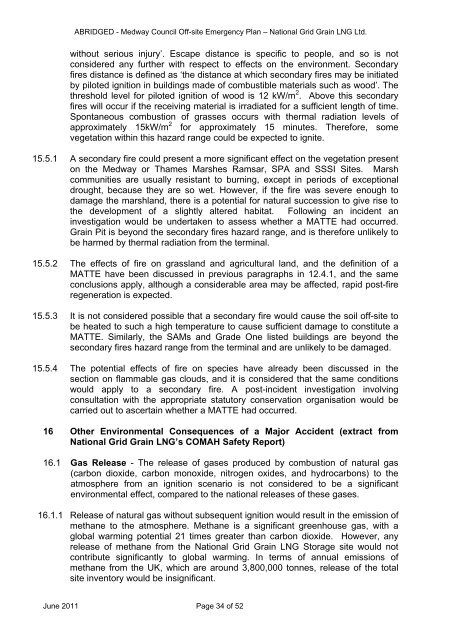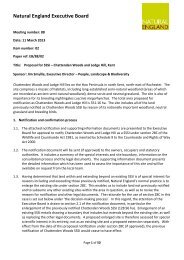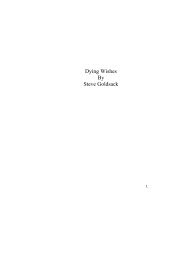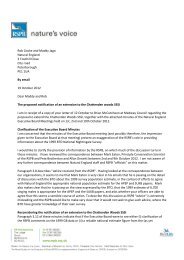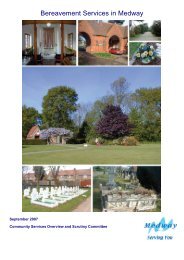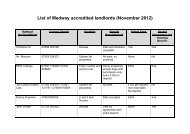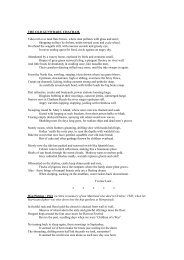MEDWAY COUNCIL COMAH OFF-SITE EMERGENCY PLAN ...
MEDWAY COUNCIL COMAH OFF-SITE EMERGENCY PLAN ...
MEDWAY COUNCIL COMAH OFF-SITE EMERGENCY PLAN ...
You also want an ePaper? Increase the reach of your titles
YUMPU automatically turns print PDFs into web optimized ePapers that Google loves.
ABRIDGED - Medway Council Off-site Emergency Plan – National Grid Grain LNG Ltd.<br />
without serious injury’. Escape distance is specific to people, and so is not<br />
considered any further with respect to effects on the environment. Secondary<br />
fires distance is defined as ‘the distance at which secondary fires may be initiated<br />
by piloted ignition in buildings made of combustible materials such as wood’. The<br />
threshold level for piloted ignition of wood is 12 kW/m 2 . Above this secondary<br />
fires will occur if the receiving material is irradiated for a sufficient length of time.<br />
Spontaneous combustion of grasses occurs with thermal radiation levels of<br />
approximately 15kW/m 2 for approximately 15 minutes. Therefore, some<br />
vegetation within this hazard range could be expected to ignite.<br />
15.5.1 A secondary fire could present a more significant effect on the vegetation present<br />
on the Medway or Thames Marshes Ramsar, SPA and SSSI Sites. Marsh<br />
communities are usually resistant to burning, except in periods of exceptional<br />
drought, because they are so wet. However, if the fire was severe enough to<br />
damage the marshland, there is a potential for natural succession to give rise to<br />
the development of a slightly altered habitat. Following an incident an<br />
investigation would be undertaken to assess whether a MATTE had occurred.<br />
Grain Pit is beyond the secondary fires hazard range, and is therefore unlikely to<br />
be harmed by thermal radiation from the terminal.<br />
15.5.2 The effects of fire on grassland and agricultural land, and the definition of a<br />
MATTE have been discussed in previous paragraphs in 12.4.1, and the same<br />
conclusions apply, although a considerable area may be affected, rapid post-fire<br />
regeneration is expected.<br />
15.5.3 It is not considered possible that a secondary fire would cause the soil off-site to<br />
be heated to such a high temperature to cause sufficient damage to constitute a<br />
MATTE. Similarly, the SAMs and Grade One listed buildings are beyond the<br />
secondary fires hazard range from the terminal and are unlikely to be damaged.<br />
15.5.4 The potential effects of fire on species have already been discussed in the<br />
section on flammable gas clouds, and it is considered that the same conditions<br />
would apply to a secondary fire. A post-incident investigation involving<br />
consultation with the appropriate statutory conservation organisation would be<br />
carried out to ascertain whether a MATTE had occurred.<br />
16 Other Environmental Consequences of a Major Accident (extract from<br />
National Grid Grain LNG’s <strong>COMAH</strong> Safety Report)<br />
16.1 Gas Release - The release of gases produced by combustion of natural gas<br />
(carbon dioxide, carbon monoxide, nitrogen oxides, and hydrocarbons) to the<br />
atmosphere from an ignition scenario is not considered to be a significant<br />
environmental effect, compared to the national releases of these gases.<br />
16.1.1 Release of natural gas without subsequent ignition would result in the emission of<br />
methane to the atmosphere. Methane is a significant greenhouse gas, with a<br />
global warming potential 21 times greater than carbon dioxide. However, any<br />
release of methane from the National Grid Grain LNG Storage site would not<br />
contribute significantly to global warming. In terms of annual emissions of<br />
methane from the UK, which are around 3,800,000 tonnes, release of the total<br />
site inventory would be insignificant.<br />
June 2011 Page 34 of 52


